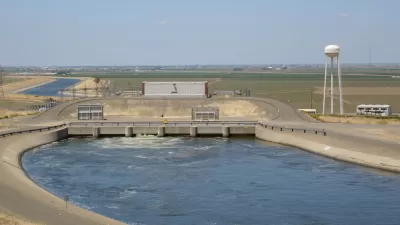'Huge' is an understatement. Revenues were less than 2 percent of what was forecasted. The uncertainty of the continuance of the program may be responsible. The plummet in revenues to high-speed rail adds to uncertainty of the $64 billion project.
The nation's only cap-and-trade program run by a state suffered an unanticipated setback when insufficient buyers purchased carbon allowances at the quarterly auction this month.
"The results of last week’s quarterly auction were posted [PDF] and revealed that instead of the $500-plus million expected from the sale of state-owned allowances, the state will get only about $10 million, less than 2 percent," writes Dan Walters, columnist for The Sacramento Bee.
The poor results confirmed reports circulating in financial circles that the cap-and-trade program has begun to stumble...but whether it’s a one-time dip or the harbinger of a more permanent down-market is uncertain.
[Gov.] Brown has submitted a plan to spend $3.1 billion in auction proceeds in 2016-17, both leftover funds from past auctions and an estimated $2 billion from those during the fiscal year. The plan covers a wide variety of projects and programs [see below], including a major allocation to support the state’s high-speed rail project.
High-speed rail
"The quarterly auction, conducted May 18 and announced [May 25], will provide just $10 million for state programs, including $2.5 million for the bullet train," writes Ralph Vartabedian for the Los Angeles Times. "The rail authority had been expecting about $150 million."
Whatever prompted the lack of buyers, the auction is a stark example of the uncertainty and risk of relying on actively-traded carbon credits to build the bullet train, a problem highlighted in recent legislative testimony by the Legislative Analyst's Office and a peer-review panel for the $64-billion high-speed rail.
The rail authority's recently released 2016 business plan had counted on getting about $10.6 billion from the greenhouse gas fees through 2050, about half of it by borrowing on the future income stream in about 2025.
"How all this affects high-speed rail’s budget is uncertain," writes Melody Gutierrez for the San Francisco Chronicle.
Jessica Peters, principal fiscal and policy analyst for the Legislative Analyst’s Office, said the rail authority is mostly relying on federal money now, but plans to use cap-and-trade revenue once it begins building its planned line to San Jose.
Peters said the analyst’s office found it problematic that the rail authority’s business plan relies heavily on the cap-and-trade revenue in future years, particularly given that the program is authorized only through 2020.
Effect will be felt on other programs as well.
The reduction in revenue will be felt by affordable housing programs, the state Transit and Intercity Rail Capital Program, efforts to reduce carbon emissions by transit agencies and the Low Carbon Transportation Investments and Air Quality Improvement Program run by the California Air Resources Board (CARB).
Future of cap-and-trade
While the California Air Resources Board states that it shall continue the program after the authorizing legislation, AB 32, the California Global Warming Solutions Act of 2006, ends in 2020, there is some degree of uncertainty. The landmark legislation called for reducing state greenhouse gas emission to 1990 levels by 2020. The legislature attempted unsuccessfully to renew the legislation last year.
"There’s a fierce, albeit mostly private, debate over whether the cap-and-trade system can legally exist after 2020, or would have to be reauthorized by the Legislature," adds Walters. "Meanwhile, there’s a pending lawsuit, filed by business groups, that seeks to have the system branded a tax, which would require a two-thirds legislative vote."
Vartabedian lists three reasons for the dramatic drop in revenues, with one being positive from a climate change perspective: AB 32 is working, and major emitters have dramatically cut emissions. However, the explanation could be simpler:
David Clegern, a spokesman for the state Air Resources Board, said he believed the auction results reflected simple volatility.
FULL STORY: California carbon emission auction proceeds fall short

Study: Maui’s Plan to Convert Vacation Rentals to Long-Term Housing Could Cause Nearly $1 Billion Economic Loss
The plan would reduce visitor accommodation by 25,% resulting in 1,900 jobs lost.

Alabama: Trump Terminates Settlements for Black Communities Harmed By Raw Sewage
Trump deemed the landmark civil rights agreement “illegal DEI and environmental justice policy.”

North Texas Transit Leaders Tout Benefits of TOD for Growing Region
At a summit focused on transit-oriented development, policymakers discussed how North Texas’ expanded light rail system can serve as a tool for economic growth.

Why Housing Costs More to Build in California Than in Texas
Hard costs like labor and materials combined with ‘soft’ costs such as permitting make building in the San Francisco Bay Area almost three times as costly as in Texas cities.

San Diego County Sees a Rise in Urban Coyotes
San Diego County experiences a rise in urban coyotes, as sightings become prevalent throughout its urban neighbourhoods and surrounding areas.

Los Angeles County Invests in Wildfire Recovery for Parks, Trails, and Open Space
The $4.25 million RESTORE Program supports the recovery of parks, trails, and open spaces damaged by the January 2025 wildfires through targeted grants that promote community healing, wildfire resilience, and equitable access to nature.
Urban Design for Planners 1: Software Tools
This six-course series explores essential urban design concepts using open source software and equips planners with the tools they need to participate fully in the urban design process.
Planning for Universal Design
Learn the tools for implementing Universal Design in planning regulations.
Smith Gee Studio
Alamo Area Metropolitan Planning Organization
City of Santa Clarita
Institute for Housing and Urban Development Studies (IHS)
City of Grandview
Harvard GSD Executive Education
Toledo-Lucas County Plan Commissions
Salt Lake City
NYU Wagner Graduate School of Public Service




























